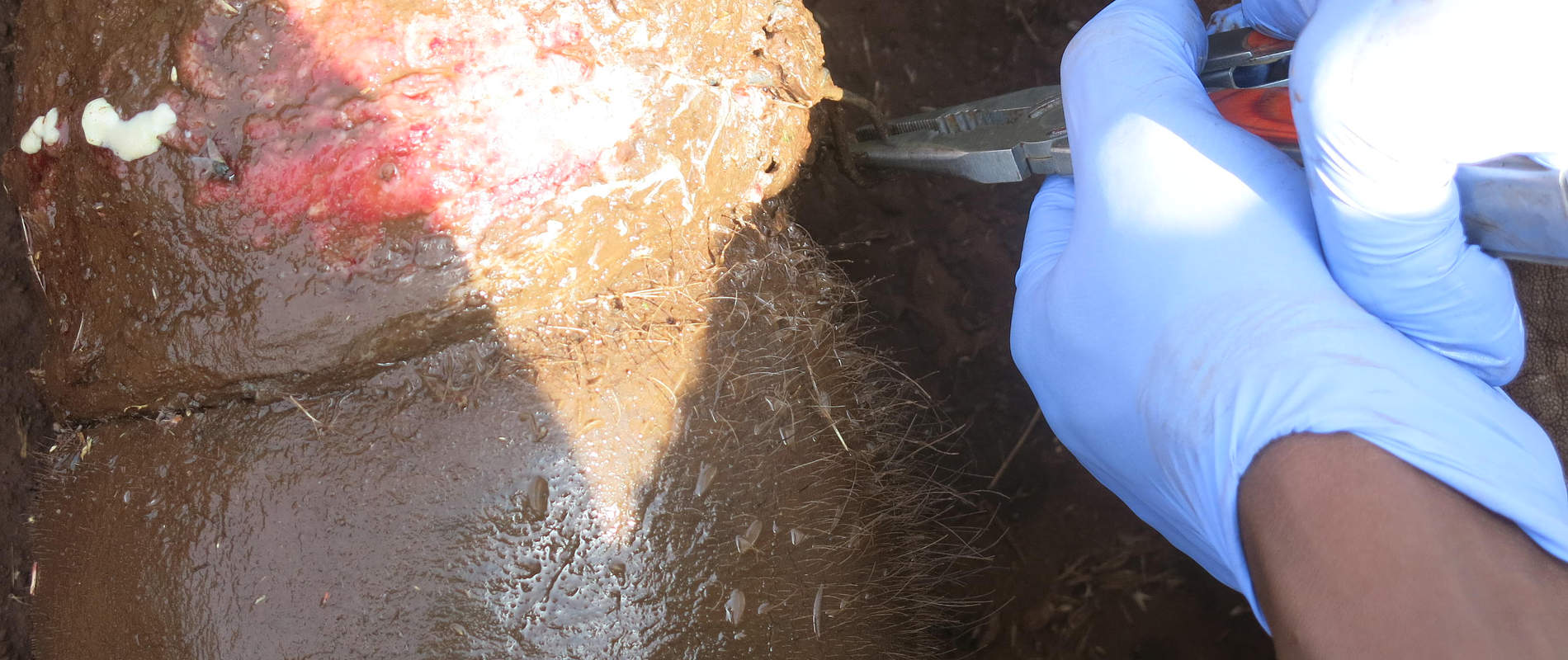EASTERN CONSERVATION AREA VETERINARY UNIT MONTHLY REPORT JUNE 2015 Report by: Bernard Rono Summary This report describes the activities of the Meru veterinary unit in the Eastern Conservation Area, in June 2015
EASTERN CONSERVATION AREA VETERINARY UNIT MONTHLY REPORT JUNE 2015
Report by: Bernard Rono
Summary
This report describes the activities of the Meru veterinary unit in the Eastern Conservation Area, in June 2015.
Snares set by poachers cause debilitating injuries or mortality in wildlife. In the month under review the unit removed snares in a lion and an elephant calf and treated secondary wounds to relieve the suffering of the affected animals. Another elephant calf in Rumuruti which sustained injuries from a snare was rescued and relocated to DSWT orphanage in Nairobi after it was abandoned by the rest of the herd.
A white rhino was treated for cutaneous wounds caused by filariae whereas an elephant in Meru National Park was treated for injuries caused by a sharp object which may be as a result of human elephant conflict. A python and leopard were captured and relocated to Meru National Park to reduce human wildlife conflict.
CASE#1 STUDY OF PARASITES IN GRANTS GAZELLE
Date: 2nd – 7th June 2015
Species: Grants Gazelle
Age: Adult
Sex: Mixed
Location: Mpala Ranch
History
This was a collaborative study between the University of Georgia and the Kenya Wildlife Service that aimed to identify and characterize endoparasites affecting Grants Gazelle and elucidate risk factors for parasite infestation.
Immobilization and Sample Collection
Sample collection was carried out between 2nd and 7th June in Mpala ranch. During this period 58 gazelles were physically restrained using nets and transported to a central location by a helicopter for processing.
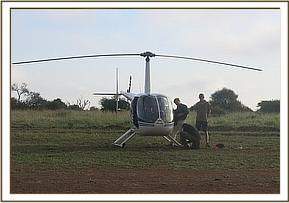

Age, sex and weight of gazelles were recorded in individual data sheets. Fecal samples were collected in fecal pots whereas whole blood and serum samples were taken in vacutainers from the jugular vein. Various tests were carried out to identify and quantify hemoparasites and helminthes in the samples by simple microscopy and molecular genetic techniques.
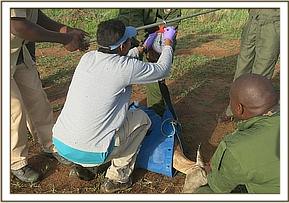

CASE#2 TREATMENT OF A WHITE RHINO
Date: 11th June 2015
Species: White Rhino
Age: Adult
Sex: Male
Location: Meru National Park
History
The warden in charge of the rhino sanctuary in Meru national park reported that a white rhino suffered severe filarial wounds on the flanks which required treatment.
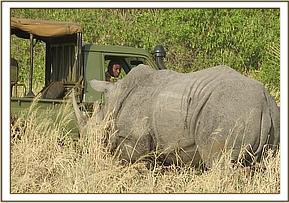

Immobilization, examination and treatment
This rhino was immobilized using a combination of M99 and 10% Xylazine delivered in a single 3ml DanInject dart from a helicopter which also monitored the darted animal and directed a team on the ground. Once immobilized the animal was stabilized using 1% Butorphanol tartate administered intravenously into superficial ear vein. It was positioned on sternal recumbency for examination and treatment.
A T- shaped cutaneous wound on the right lateral thorax caused by filariae infestation was identified. The dead tissue was debrided by washing with hydrogen peroxide and Iodine before green clay was packed into the wounds. Ivermectin 150mg was then injected subcutaneously and 20% Alamycin 60ml was injected intramuscularly.


Reversal
After treatment Naltrexone hydrochloride and Antisedan was injected intravenously to reverse the effect of anesthesia.
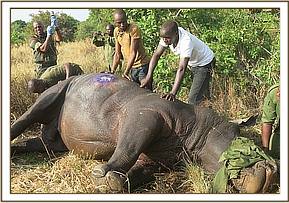

Prognosis
Wounds caused by filariae respond well to treatment and it is expected that this animal will make a complete recovery.
CASE#3 TREATMENT OF AN ELEPHANT WITH SPEAR WOUNDS
Date: 11th June 2015
Species: Elephant
Age: Adult
Sex: Male
Location: Meru National Park
History
Tour guides from Elsas Kopje lodge reported an elephant which was oozing pus from an abscess on its flank and requested treatment.
Immobilization, examination and treatment
Immobilization was achieved using M99 16mg in a 1.5 ml dart with from a vehicle after briefly herding the elephant to open ground. The dart was placed in the left gluteal muscle and induction time was five minutes.
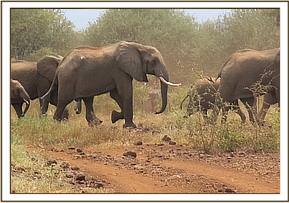

Examination showed a suppurating wound caused by a sharp objected penetrating into the abdominal muscles on the dorsal part of the right flank. The wound was washed and debrided with Hydrogen peroxide and Iodine and then given long lasting antibiotics.
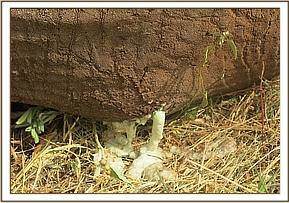



Reversal
Diprenophine hydrochloride was injected intravenously to reverse the effect of anesthesia and this elephant soon joined the rest of the herd which were waiting nearby during the procedure.
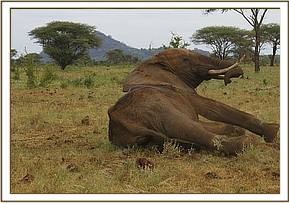

Prognosis
This animal is expected to make a slow recovery.
CASE#4 DESNARING AN ELEPHANT CALF
Date: 15th June 2015
Species: Elephant
Age: Infant – 2.5 years
Sex: Male
Location: Meru National Park
History
This elephant had a wire snare on its right hind limb and had been reported by tour guides from Elsas Kopje lodge in May but could not be traced for treatment at the time. After several weeks of searching the veterinary team found it within a herd of 20 elephants near Rojowero river in Meru park and quickly made a plan for treatment. An extra vehicle provided by the park was essential to herd this elephant to open ground.

Immobilization, examination and treatment
As elephant mothers are extremely protective of their calves the mother was first immobilized using M99. After seven minutes from the darting time she was down and the calf was then immobilized using 1mg M99. The rest of the herd formed a protective ring around the calves and had to be pushed away with a vehicle.
Examination showed a plain wire snare tightly around its lower right hind limb causing severe swelling, tissue strangulation and infected wounds. The calf also showed severe lameness. The wire snare was removed using a wire cutter and the resultant wounds debrided with Hydrogen Peroxide and Iodine before being packed with green clay. Antibiotic and antiflammatory drug were also administered.
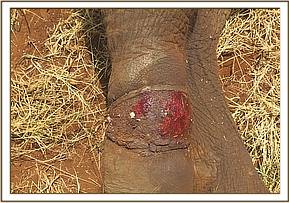

Reversal
To reverse the anesthesia the calf was given Diprenophine and restrained physically whilst its mother was then revived. Once the mother showed signs of revival the calf was released to join her. These elephants later joined their herd mates who were waiting nearby.
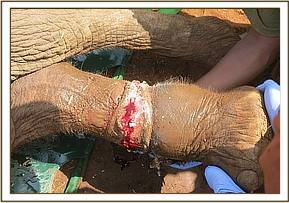

Prognosis
Though wounds caused by snares are debilitating, they respond well to treatment after removal of snare. This calf will soon recover from these injuries.
CASE#5 DESNARING A LION
Date: 17th June 2015
Species: Lion
Age: Adult
Sex: Male
Location: Meru National Park
History
Tour guides from Elsas Kopje lodge reported this lion which had a loose snare around its neck and requested for veterinary intervention.
The lion was found in the company of another male lion feeding on a zebra carcass. A brief observation of the lion showed a snare around its neck, though it was loose and had not caused any injuries the lion needed to be immobilized to remove the snare to reduce the risk of asphyxia.
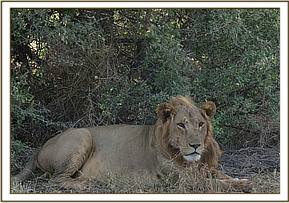

Immobilization, examination and treatment
A combination of 250mg Ketamine and 10mg 4% Medetomidine hydrochloride in a 3ml Daninject dart from a vehicle with the dart fired into the gluteal muscles. It remained calm after darting only moving a short distance before lying down with an induction time of 10 minutes.
This lion was blind folded and moved to a shade where the snare was loosened and removed.
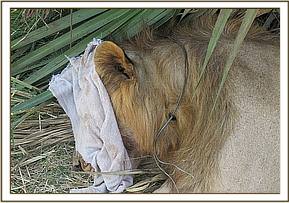

Reversal
Effect of Medetomidine was reversed using Antisedan with the lion showing complete reversal after 15 minutes of administration of reversal drugs.
Prognosis
This lion will make a full recovery.
CASE#6 EXAMINATION AND EUTHANASIA OF AN ELEPHANT
Date: 17th June 2015
Species: Elephant
Age: Adult
Sex: Female
Location: Lewa Wildlife Conservancy
History
This elephant was reported by rangers on patrol who found it recumbent in a stream. Efforts to assist it onto its feet were unsuccessful therefore they requested veterinary intervention.
Examination and management
An examination of the elephant showed severe emaciation though no injuries were observed. An internal disease condition was suspected. This animal is estimated to have been recumbent for more than 24 hours based on evidence from the surrounding environment.


To relieve suffering euthanasia was recommended. Later its tusks were removed and taken into custody by the senior warden in Laikipia.
CASE#7 SEARCH FOR AN INJURED BLACK RHINO
Date: 22nd June 2015
Species: Black Rhino
Age: Sub adult – 4 years
Sex: Female
Location: Ol Pejeta Conservancy
History
Rangers on patrol in OPC reported that a female black rhino had been injured during a fight with a bull. Blood was seen oozing from the abdomen which seemed to have been perforated.
The team visited the ranch on 22nd June to treat this injured rhino. However, a two day search for this individual by a fixed wing plane and ground team could not locate it and it has not been seen again despite the rather severe injuries it sustained in the fight.
CASE#8 RESCUE OF AN ELEPHANT CALF
Date: 23rd June 2015
Species: Elephant
Age: Infant – 15 months
Sex: Male
Location: Rumuruti Forest – AA Flower farm
History
The manager in charge of AA flower farm reported to the DSWT office in Nairobi that an injured and abandoned elephant calf was seen roaming near the electric fence of his farm. There were no other elephants nearby.
Treatment
The Meru veterinary unit visited the farm to treat injuries on the calf which showed severe lameness caused by a fabric snare on its right forelimb and a spear wound to the head. As this calf was milk dependent a DSWT rescue team had already restrained the animal and it was transported to the DSWT nursery in Nairobi.
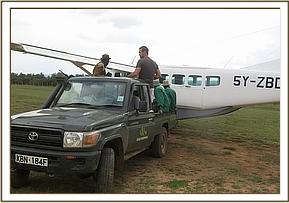

Prognosis
The calf was named SImotua and is doing well at the nursery.
CASE#9 RESCUE OF A PYTHON
Date: 27th June 2015
Species: Python
Age: Unknown
Sex: Unknown
Location: Ndoleli community land, relocated to Meru National Park
History
A python was reported to have caused a threat to livestock and community in Ndoleli area 10km from Meru national park. It was captured and relocated to the park on 27th June 2015.
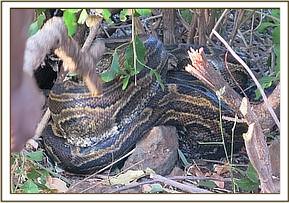

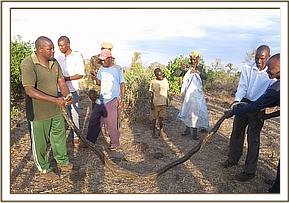

CASE#10 RELOCATION OF A LEOPARD
Date: 27th June 2015
Species: Leopard
Age: Adult
Sex: Male
Location: Community land near Ol Jogi Ranch
History
This leopard was captured in community land near Ol Jogi ranch where it was feeding on livestock. It was captured in a trap and transported to the expansive Meru park where it was released.
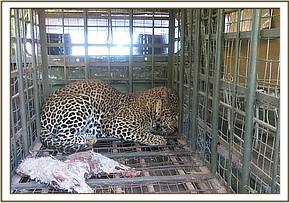

Acknowledgement
We would like to acknowledge financial support provided by the David Sheldrick wildlife Trust to facilitate treatment of injured wildlife and reduce suffering in wildlife.
